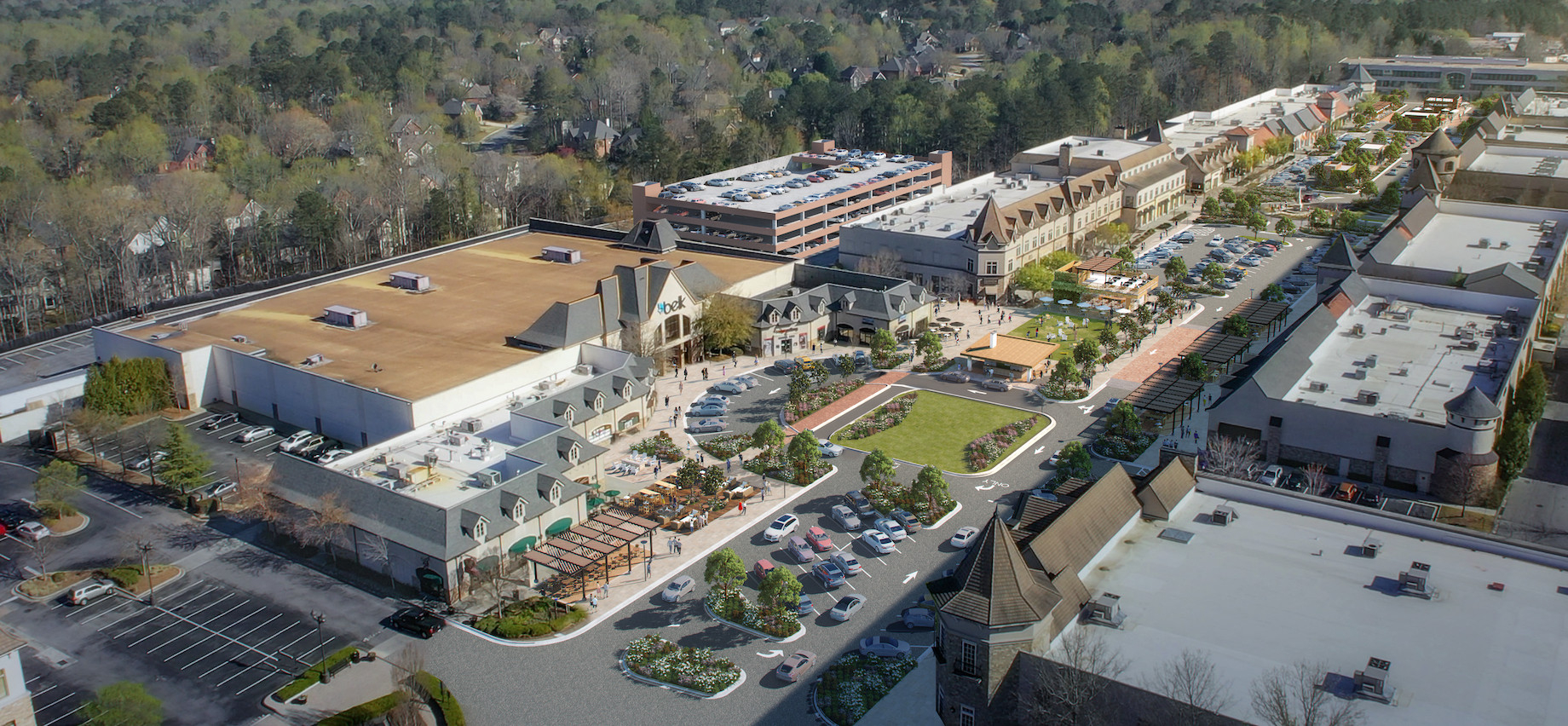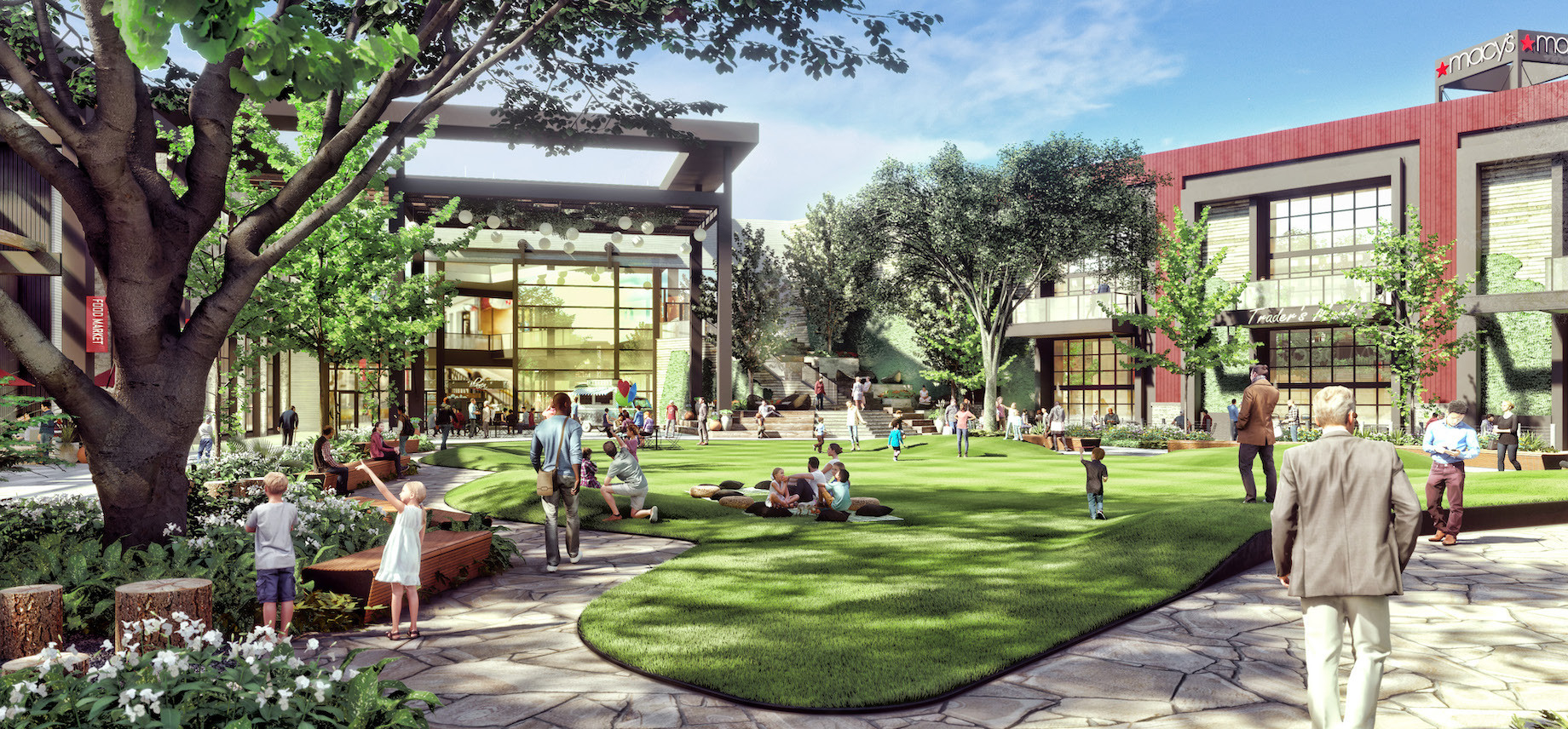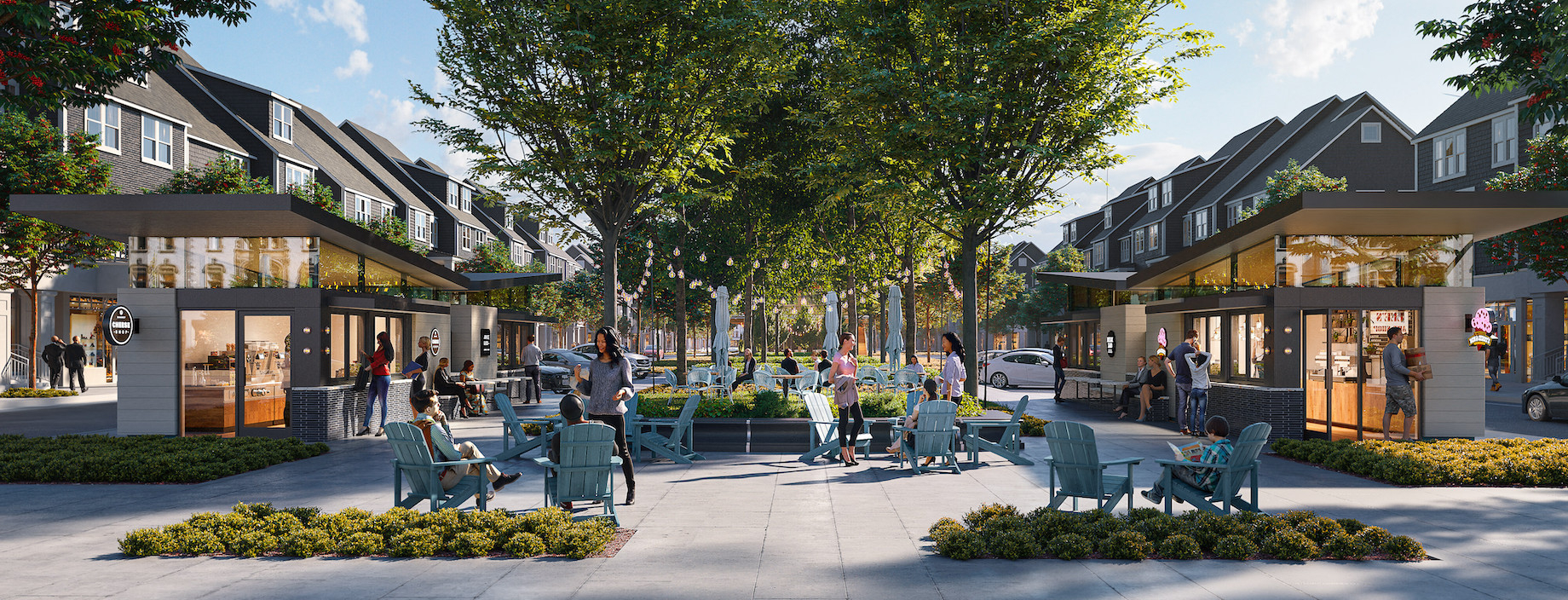Suburbanites are clamoring for pedestrian-friendly oases. Often, a “city in the suburbs” vision centers on shopping streets lined with hip boutiques and consignment shops, along with a public lawn ringed by cafes, bars and restaurants and enlivened by trees, Edison lights, fountains and a stage. But some residents and politicians in U.S. suburbs balk at what developers and architects say are critical components of live-work-play developments: the higher-density apartments, hotels and offices that help pay for these projects.
A few recent examples of such pushback:
- This past March, the board of commissioners in Huntersville, North Carolina, rejected North American Properties’ proposal to add a 175,000-square-foot office and retail building and five new levels of structured parking to mixed-use Birkdale Village. The developer, which had scaled back an earlier plan, went back and forth with officials for months and held 22 community meetings in all.
- Officials in suburban Alpharetta, Georgia, this past November rejected Trademark’s bid to add 875 apartments to the site of the moribund North Point mall. Some councilmembers called for fewer apartments and 250 additional, for-sale townhomes, with one official decrying renters as people who aren’t “invested in the community.”
- This month, officials in the Atlanta suburb of Marietta rejected Bridger Properties’ bid to erect a 135-unit apartment building next to Marietta’s bustling, live-work-play district, known for its food halls, offices, shops and public spaces. In speaking of the project, Mayor Steve Tumlin reportedly quipped, “We’re Marietta, not New York.” A few days later, Marietta officials implemented a six-month freeze on developers’ applications to build new apartments.
Progress on Suburban Mixed-Use
Developers have had plenty of success bringing higher-density, mixed-use projects — both ground-up and as part of redevelopments — to the suburbs. Trademark, for one, has been doing so for most of its 31-year history. Its latest project is set to bring office buildings, a boutique hotel and several hundred residential units, along with new restaurants and retail, to the 470,000-square-foot Lincoln Square in Arlington, Texas. “We have had the pleasant opportunity to work with the city manager, mayor and all of the city council on a major redevelopment of what today is a tired shopping center, basically,” said executive vice president of development Jeff Johnson. “It is sitting on 46 acres of great real estate. Officials in Arlington understand that these are symbiotic uses that support one another and are sustainable long term.”
Likewise, North American Properties and joint-venture partner Nuveen Real Estate will break ground Thursday on a mixed-use redevelopment of The Forum in the Atlanta suburb of Peachtree Corners. The plan centers on adding a 125-key boutique hotel, 381 apartments, a parking deck, central green space, and food-and-beverage tenants.

The Forum of Peachtree Corners is an example of a project for which residents and officials have supported the higher-density vision. “Some communities understand the economic drivers,” said North American Properties’ Tim Perry.
Peachtree Corners residents and officials have been receptive to the higher-density vision, according to NAP Atlanta managing partner Tim Perry. “Some communities understand the economic drivers,” he said. “They know that people want amenities and that if their community doesn’t have an experiential mixed-use development, a place with great food-and-beverage where people can socialize and spend time, they’ll go live somewhere else.”
Those economic drivers include rising demand for what Johnson described as “renter-by-choice” multifamily developments: attractive buildings packed with amenities and served by structured parking with rents that can compare to residential mortgage payments. “The quality of what is getting built is going up,” the executive said.
It all means that declining malls and open-air properties in the burbs can make for attractive redevelopment opportunities. A prime example is the 30-year-old, 1.3 million-square-foot North Point mall, which Trademark aims to transform on behalf of owner New York Life. The Alpharetta asset went back to the lender in January 2021 as its former owner faced the maturation of a $250 million loan.

Trademark aims to transform New York Life’s 1.3 million-square-foot North Point mall, though officials in suburban Alpharetta, Georgia, this past November rejected Trademark’s bid to add 875 apartments to the site. Photo credit: Torti Gallas + Partners
NIMBY Resistance to Apartments
Notwithstanding rising demand for such reinventions, the Not in My Back Yard perspective sometimes creates major snags for developers in affluent suburbs, such as Alpharetta. “It is common around the country in suburban areas,” said Trademark founder and CEO Terry Montesi. “The NIMBYs that fight multifamily rental properties or apartments tend to just say: ‘All apartments bad.’ Oftentimes, the projects don’t go forward.”
Employers and urban planners understand the benefits of mixed-use development, according to Montesi, but he said NIMBYs tend to be uninformed about real estate economics and trends. “A lot of suburbanites have not studied great cities and streets, how these walkable areas work and why they are better.”
In Montesi’s view, NIMBYism persists in part because of the bad reputation of garden apartments built on cheap suburban land for decades. Served by surface parking, these often poorly maintained buildings typically had lower-quality finishes and construction. As they deteriorated over the years, their rents declined and crime and other problems worsened. “They did not age well,” Montesi said. Today, when suburban NIMBYs hear the words “apartments” or “multifamily,” they’re liable to imagine those rundown apartments, not amenity-rich, high-quality residential buildings with structured parking. “They think: ‘Oh, these renters. They commit crimes. They don’t care about my community. They are not our kind of people,’” Montesi said. “It’s a common mentality.”
Gridlock Fears
Misconceptions about parking and traffic also can fuel NIMBYism. At Birkdale Village, NAP wanted to add 450 parking spaces by building an office building on a former big-box site with five new levels of structured parking. The deck would have cost of about $12 million. Nuveen Real Estate and NAP already had added lifestyle amenities to the 20-year-old property and modernized its aesthetic in a $20 million redevelopment delivered last year. Nuveen, the owner of Birkdale Village, had brought in NAP in 2020 as a redevelopment specialist and equity partner.
Under NAP’s business plan, the deck’s 75-space first level would have been open to the public at all times, as would other lots on the property. During the week, though, most levels of the deck would have been reserved for paying workers at a new six-story, $78 million, Class A office building with ground-floor retail, and the public would get free access to the entire deck again after 5 p.m.
According to NAP director of public relations Britni Johnson, the revenue from the office building was critical to making the deck free to the public in the evening and on weekends. Some residents, though, still objected. “About 70% of our guests are onsite only after 5 p.m. or on weekends, so during regular working hours, there is usually ample parking space available,” she said. “Office is also the only product type that provides shared parking opportunities, but some people couldn’t quite grasp that we needed the office building to be able to pay for the parking deck.”
NIMBYism also can arise out of the misconception that greater density leads to more traffic. “It’s: ‘Oh my gosh, you’re adding 1,000 units? What are we going to do with all this traffic?’” added Jeff Johnson. But in fact, Perry observed, typically the opposite is true. “Density has a traffic-recapture benefit; since more needs can be met in one place, fewer cars are traveling to other places around town and causing road congestion.”
Birkdale Village is about half a mile from the Interstate 77/North Carolina Highway 115 corridor, and studies show that bolstering density near such major infrastructure improves traffic congestion, Perry said. “The Huntersville town board completely ignored its 2040 comprehensive plan that identified Birkdale as a higher-intensity development area,” he stated. “Representatives cost their town a competitive economic benefit while failing to control property taxes for their citizens who deserve better.”
Moreover, adding density in the form of a new boutique hotel, offices, additional multifamily and structured parking would have ramped up daytime traffic and driven higher tenant sales, allowing NAP to strengthen the property further, said Britni Johnson. Over the past three years, the developer has signed leases with 22 new tenants at Birkdale Village and renewed another 15 legacy brands. Five additional leases are in the works.

The $20 million redevelopment of Birkdale Village by North American Properties and Nuveen Real Estate delivered amenities and public spaces like the Grove; the Plaza, pictured at top; concierge and valet services; and retail jewel boxes. However, officials pushed back on plans for a boutique hotel, more multifamily residential, a new parking deck and Class A offices.
Making the Case
So what can mixed-use developers do to push back against NIMBY misconceptions? It can help to gauge community interest as early as possible in the planning process, said MG2 principal Mark Taylor. The architecture and design firm hasn’t faced much pushback on density in its suburban collaborations with mixed-use developers in the West and Pacific Northwest, he said.
The latest of its projects is the redevelopment of Macerich’s Flatiron Crossing in Broomfield, Colorado. “We’re looking at between 250 and 350 multifamily residential units right now, but there will be multiple phases, which will probably get the number closer to 700 units,” Taylor said. “It’s all centered around a nine-acre, programmed and activated green space with retail buildings, restaurants and entertainment. Residential — with activated ground-level retail at its doorstep — is a key component for making this project pencil out.”
Not everyone in suburban communities will understand the benefits of such mixed-use projects, so Taylor advised developers to enlist vocal support from those who do. “Successful projects follow some time-honored steps, which include listening to the community, looking for common ground and identifying steps you can take to build trust,“ he said. “People need to trust that your project is going to enhance the community overall.”
“Residential — with activated ground-level retail at its doorstep — is a key component for making this project pencil out.”
Developers also could consider being as transparent as possible about the costs of the project and what it will take to pay for those public green spaces and enjoyable amenities, added CREModels managing director Mike Harris. His firm routinely creates financial models for real estate projects, as well as the offering memorandums given to potential investors in mixed-use developments. “We’re seeing declines in traffic and value at a lot of older malls and shopping centers around the country, and many of these properties could really benefit from a mixed-use reinvention,” Harris said. “However, public officials and community stakeholders need to understand that if they want that cool project with urban streetscapes and best-in-class retailers to get built, then they have to give the developer the density called for in the pro forma. The tenants, too, want the higher traffic and sales that density provides. You’re not going to get best-in-class operators without it.”
Presenting those financial realities to residents and officials might not guarantee a developer wins over the community, Harris said, but “it certainly can help.”
Despite going through hoops to educate the public, mixed-use developers might still be looking at an uphill battle now and again in some suburban markets. Britni Johnson noted that despite NAP’s strong commitment to community engagement related to Birkdale Village, rumors circulated in Huntersville that NAP was unwilling to engage. “We had 22 public meetings that we participated in, but we also hosted multiple, one-off meetings with individual neighbors who live right behind the project and we had many one-off meetings with individual commissioners,” she said. “In the end, it did not matter to some people what we said or how we adjusted our plans.”
Despite the occasional NIMBY-driven setback, Perry is optimistic about the future of smart growth in the suburbs. More Millennials, he noted, are starting to move from hip downtown neighborhoods back to the ’burbs where they grew up, and they are bringing their in-town tastes with them. “They want all of that close to home,” Perry said. “It’s a huge trend.”
By Joel Groover
Contributor, Commerce + Communities Today